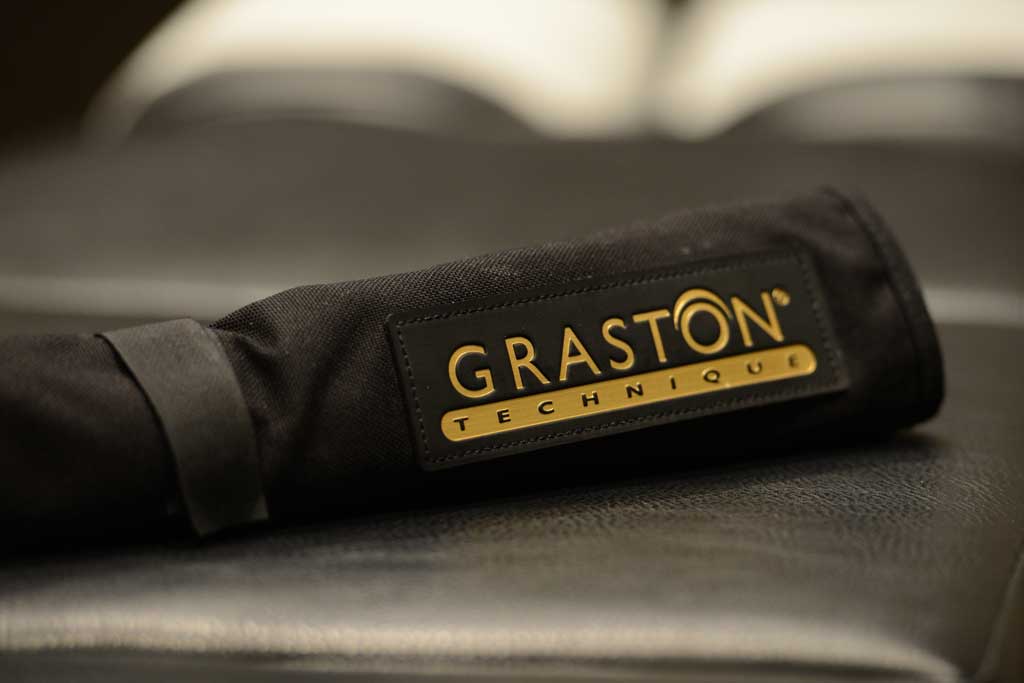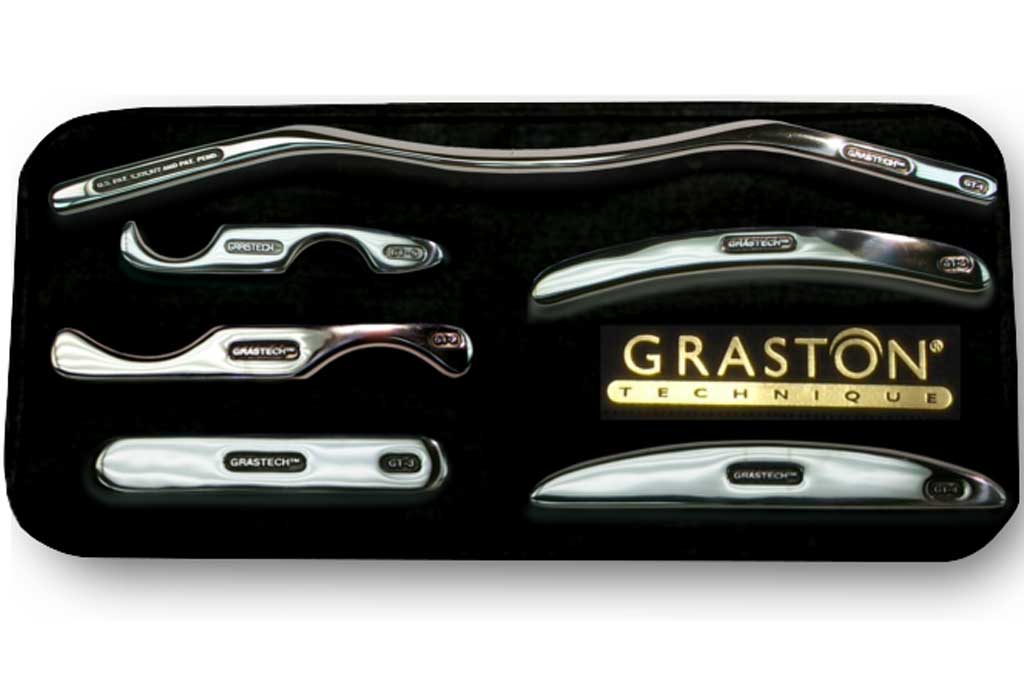What is the Graston Technique?
Graston Technique is a progressive technique that uses an mobilization instrument to allow health professionals to actively break down scar tissue and fascia constraints that result from an injury.
Scar tissue and facial adhesions are the result of blunt force trauma, sprains, strains, and repetitive motion disorders. Blunt force trauma is when there is direct impact to a specific region of the body. Strains and sprains occur when the ligament of a specific joint, or the associated muscles of the joint are stretched beyond their range of motion and anatomical limits. This can cause an injury to the joint or to the surrounding tissue.
Repetitive motion disorders are injuries of the musculoskeletal and nervous system that may be caused by repetitive tasks, forceful events, vibrations, mechanical compression (pressing against a hard surface), as well as awkward body positions (example: sleeping in a strange position). It is important that your musculoskeletal and nervous systems to be at their full functioning capacity in order to allow your body to move and function optimally.
Graston Technique utilizes specially designed stainless steel instruments to detect and effectively treat areas which exhibit soft tissue fibrosis or chronic inflammation. The beveled edges of the tool allow Graston Technique Instruments to hold to the various curves of the body. The instruments vibrate and help separate restrictions and adhesions within the body.
Graston Technique works best on injuries and conditions that are closer to the surface, as the instruments aren’t able to access the deeper tissues of the body the way other manual techniques can. Graston Technique also utilizes icing, stretching and strengthening exercises.

Types of Scar Tissue
There are several different types of scar tissue as follows:
Hypertrophic
Hypertrophic scar tissue is large uneven scar tissue.
Keloid
Keloid scar tissue is raised on the skin surface and generally extends beyond the borders of the injury that resulted in the scar.
Atrophic
Atrophic scar tissue is deep and leaves indentations on the skin surface.
Adhesions
Adhesions are scar tissues that form connections within the structures and organs of the body, and can lead to malfunction of organs if severe.
Why is scar tissue a problem?
- Scar tissue limits range of motion (ROM) and causes pain
- Scar tissue can reduce a patient’s ability to function normally
- Scar tissue inhibits the proper flow of oxygen which in turn creates a low acidic pH level
- Low pH levels can inhibit the healing processes of the body
- Lack of oxygen (o2) can inhibit blood flow to the affected connective tissues
- Nerves within scar tissue can cause arthritis and eventual deterioration of joints
How are Graston Technique Instruments Used?
Graston Technique instruments are used to help distinguish scar tissue from other conditions within the body that restrict or prevent movement. They are used to “catch” onto the tissue in order to detect the affected area that is causing the restriction or prevention of movement.
After the area in question has been identified, the instrument will be used to assist in the break-up of scar tissue to help alleviate pain and pressure, and restore movement.
What conditions does the Graston Technique treat?
- Carpal Tunnel Syndrome
- Rotator cuff injuries
- Tennis Elbow
- Golfer’s Elbow
- Shin splints
- Lower back pain
- Neck pain
- Fibromyalgia

What kind of results can I expect from Graston Technique?
At Broadway AT Yew Chiropractic & Massage, our Vancouver Chiropractors find that patients report and enjoy increased mobility, greater range of motion and better performance. Normally Graston Technique would be used as a complement to spinal manipulative therapy and massage therapy. It is also, super important that patients to not try to do this at home, as one could cause sever damage and bleeding. Never let an non-certified practitioner do Graston Technique on you.
What is the history of Graston Technique?
Athletes originally developed Graston Technique to assist health professionals in treating sports related injuries. These health professionals include Chiropractors, Athletic Therapists (AT), Occupational Therapists (OT), and Physical Therapists (PT). According to the Graston Technique website, www.grastontechnique.com/AboutUs.html, GT is utilized at 2,400 outpatient services as well as 66 industrial locations. There are more than 360 amateur sport organizations as well as professional athletic organizations who are involved in using Graston Technique.
Graston Technique is also associated and used within more than 50 university and college athletic programs.
Why is Graston Technique so effective?
Graston Technique offers the following benefits:
- Overall treatment time is decreased
- Allows for a faster recovery from any rehabilitation treatments
- Helps reduce the need for medications
- Chronic conditions that were expected to be stable are resolved due to GT
- Reduces any minor or major changes within fibrous tissue
- Is receiving Graston Technique treatment painful?
As a patient of Graston Technique, one may feel discomfort on a minor level during the treatment. Patients may also experience minor swelling and/or bruising post-treatment. These are normal occurrences and will ease within a day or so.
How many treatments do I need receive?
Standard treatment usually involves twice weekly treatments for four to five weeks. This can be adjusted either way based on how well the patient responds to the treatment.
Who can perform Graston Technique?
Graston Technique can be performed by clinicians who have been trained and are certified in the technique.
To become certified, the clinician must attend an on-site training course. These courses are offered throughout the year at a variety of locations. Once certified, Grafton Technique Instruments can be obtained.

